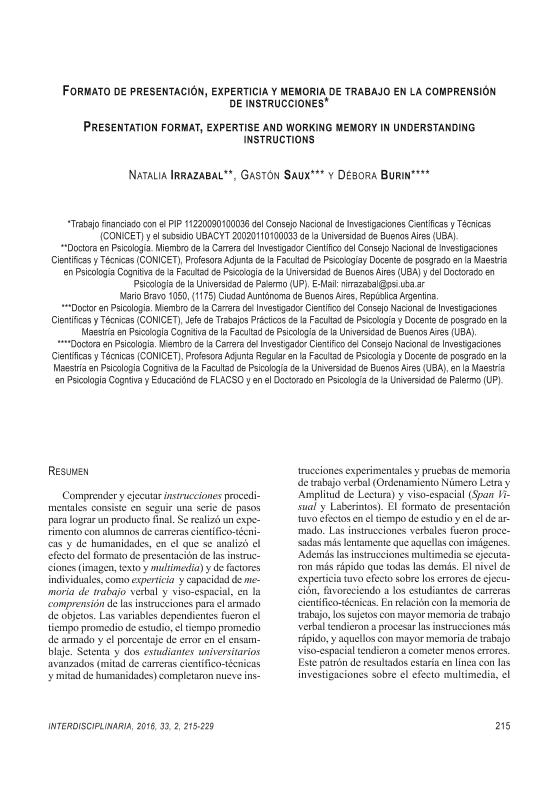Artículo
Comprender y ejecutar instrucciones procedimentales consiste en seguir una serie de pasos para lograr un producto final. Se realizó un experimen to con alumnos de carreras científico-téc nicas y de humanidades, en el que se analizó el efecto del formato de presen tación de las instrucciones (imagen, texto y multimedia) y de factores indivi duales, como exper ticia y capacidad de memoria de trabajo verbal y viso-espacial, en la com prensión de las instrucciones para el armado de objetos. Las va riables dependientes fueron el tiempo promedio de estudio, el tiempo promedio de armado y el porcentaje de error en el ensamblaje. Setenta y dos estudiantes universitarios avanzados (mitad de carreras científico-técnicas y mitad de humanidades) completaron nuev e instrucciones experimentales y pruebas de memoria de trabajo verbal (Ordenamiento Número Letra y Amplitud de Lectura) y viso-espacial (Span Visual y Laberintos). El formato de presentación tuvo efectos en el tiempo de estudio y en el de arma do. Las instrucciones verbales fueron procesadas más lentamente que aquellas con imágenes. Además las instrucciones multimedia se ejecutaron más rápido que todas las demás. El nivel de experticia tuvo efecto sobre los errores de ejecución, favoreciendo a los estudiantes de carreras científico-técnicas. En relación con la memoria de trabajo, los sujetos con mayor memoria de trabajo verbal tendieron a procesar las instrucciones más rápido, y aquellos con mayor memoria de trabajo viso-espacial tendieron a cometer menos errores. Comprehending instructions is a frequent task in everyday life. A set of instructions consists of a series of steps that indicate how to produce a final state. In cognitive terms, following a set of instructionsimplies building an internal representation of the procedure depicted in the message, with the aim of reaching the final state accurately and fast. Therefore, comprehending instructions is intrinsically associated with executing them efficiently. Whereas previousresearch on the area hasfocused mainly on traditional indicators of comprehension, such as reading times and recall, this study incorporates measures of the actual execution (i.e., the time spent to perform the instruction and the error rate) in addition to more traditional processing measures. Additionally, this study analyzes the potential effects of both cognitive and design features on comprehension.Acore aspect in the study of processing instructions is to determine which factors are more effective in helping users to achieve consistent and reproducible results. This experiment examined the effect of the presentation format of the instructions, and individual factors such as expertise and verbal and visuo-spatial working memory capacity on comprehending and executing a set of instructions. Dependent variables were the mean time to study the instructions, the mean time to assembly the objects, and the percentage of errors during assembly. Seventy-two advanced (fourth-year) college students, half in scientific-technical fields, and the other half in humanities, participated voluntarily. All participants completed an experimental assembly task which required building Lego objects. Each one consisted of nine experimental trials of five-steps instructions in one of the three presentation formats (pictorial only, verbal only, or combined verbal and pictorial information assigned randomly), followed by verbal (Letter Number Sequencing, WAIS-III and Reading Span), and visuo-spatial (Spatial Span, WMS-R and Mazes, AWMA) working memory tests. Each individual session lasted about an hour. Three ANCOVAS were conducted to examine the effect of presentation format and expertise on study time, execution time and error rates (%). Verbal and visuo-spatial working memory capacity measures were included as co-variables. The presentation format had effects both on the time to study and the time to perform the instructions: verbal only presentations were processed slower than presentationsincluding pictures(image only or multimedia), and were slower than multimedia in assembly. Expertise, on the other hand, had its effect on execution errors, favoring students of scientific and technical background, partialing out individual differences such as working memory capacity. There was a tendency for students with higher verbal working memory to processinstructionsfaster, and for those with higher visuo-spatial working memory to assembly objects more precisely. Overall, these results suggest that images are more effective in representing procedural instructions, since the pictorial and multimedia formats seemed to facilitate the comprehension of the instruction. Results also suggest that the combined format ofsentences and pictures enhanced efficiency during assembly, as evidenced by the faster execution time observed in the multimedia condition. This pattern of results is in line with the multimedia advantage and the efficacy of images found with other text types, while extending it to procedural instructions.Additionally, visuo-spatial working memory and expertise seemed to influence the execution of the instructions. Verbal working memory capacity also seemed to be involved when studying and processing the instructions, regardless of the presentation format, but not when executing the procedure. In conclusion, in order to maximize their efficiency, the format in which the instructions will be presented as well as the cognitive characteristics (i.e., working memory capacity and expertise level) of the potential users should be incorporated into the design of procedural instructions.
Formato de presentación, experticia y memoria de trabajo en la comprensión de instrucciones
Título:
Presentation Format, expertise and working memory in understanding instructions
Fecha de publicación:
08/2016
Editorial:
Centro Interdisciplinario de Investigaciones en Psicología Matemática y Experimental
Revista:
Interdisciplinaria
ISSN:
1668-7027
Idioma:
Español
Tipo de recurso:
Artículo publicado
Clasificación temática:
Resumen
Palabras clave:
instrucciones
,
comprensión
,
multimedia
,
memoria de trabajo
Archivos asociados
Licencia
Identificadores
Colecciones
Articulos(SEDE CENTRAL)
Articulos de SEDE CENTRAL
Articulos de SEDE CENTRAL
Citación
Irrazabal, Natalia Carolina; Saux, Gaston Ignacio; Burin, Debora Ines; Formato de presentación, experticia y memoria de trabajo en la comprensión de instrucciones; Centro Interdisciplinario de Investigaciones en Psicología Matemática y Experimental; Interdisciplinaria; 33; 2; 8-2016; 215-229
Compartir




